Cleaning the aquarium glass regularly can reduce the accumulated algae and dirt, and keep the ecosystem in the aquarium balanced. Today, we are likely to share with you how to clean the inside glass of an aquarium and cover some tools for cleaning the aquarium’s inside glass. Let’s get started!
Content Table
Can You Clean a Fish Tank with the Fish Inside?
Exactly, you can clean a fish tank with the fish inside. When you clean the fish tank, there is water remaining in the tank. In addition, the process you catching the fish will bring more stress to them and shock them, compared to cleaning slowly around them. Here are some tips about how to clean a fish aquarium with fish inside.
Change water regularly
To remove debris in tanks, such as ammonia and nitrates, it is recommended to change 10-15 percent of the water each week. Besides, it is also feasible to change 20-25 percent of the water in tanks every two weeks. On the other hand, the excessive chemicals and dissolved elements are not beneficial to fish tanks. Thus, when you are changing water, you should pay attention to the water parameters. By the way, if you want to learn more about aquarium water sources, you can go for aquarium water sources. Moreover, check the water parameters regularly, consequently, you can keep the water conditions stable and reduce injury to your little fish.
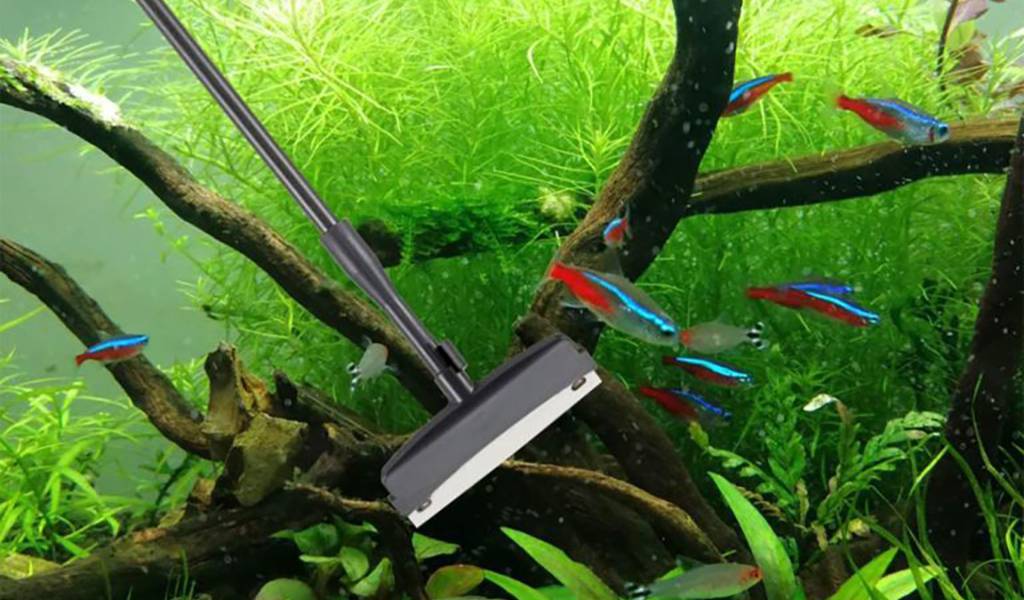
Clean the filter media regularly
It is better not to clean the filter media too thoroughly and frequently. As a result, the beneficial bacteria in the filter media would not get destroyed. Aside from that, you can clean your filter media with water in aquariums.
Vacuum the substrate in tanks
There are specks of dirt on the substrate, so it is essential to vacuum the substrate to keep it clean. An aquarium gravel vacuum is an excellent tool. And the ideal substrate helps accumulate beneficial bacteria.
What Can Be Used to Clean the Inside Glass of the Fish Tank?
There are ways to clean the aquarium inside the glass. To begin with, you can clean the inside glass by hand. And it is better to wear aquarium-safe gloves, hence, the oil in your hands will not be released into the water. On the other hand, you can apply some fish that eat algae, like Catfish, and Amano shrimp. Which one you should choose is determined by the size of your tanks, the fish and creatures in your aquarium, and the types of your fish tank, such as freshwater or saltwater tanks.
In this segment, we will cover tools that you can use to clean the inside glass of fish tanks. You can select the best one for your needs.
Magnetic aquarium glass cleaner
With a magnetic fish tank glass cleaner, you can clean your aquarium without wetting your hands. The magnets are on both sides, as you move the outside one, the internal one will move with it. Due to the strong magnetism of the glass cleaner, it can stick tightly to the glass and will not fall off. You can choose an ideal one according to the thickness of your fish tank. By the way, a magnetic fish tank glass cleaner is a suitable option.
Aquarium cleaner tool kit
An effective aquarium cleaner tool kit can keep your aquarium clean. Generally, the tool kit may include a fishnet, algae scraper, gravel rake, flat sponge, and something like that. The fish net is for catching fish, shrimp, or other creatures in tanks and it can also clean debris. While the flat sponge is for cleaning the glass and substrate, the right-angle sponge makes sense to clean up the hard-reach corners. An algae scraper can remove stubborn algae. The aquarium cleaner tool kit would be a great choice for you.
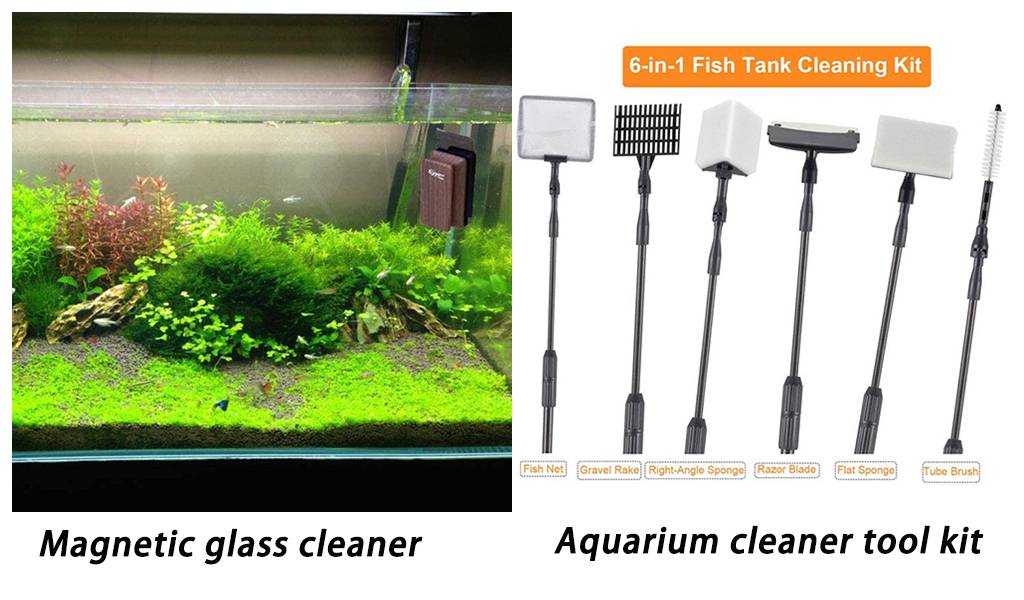
Napkins or towels
Napkins or towels help clean the dirt on the glass. They are cheap but can clean the dirt easily. Furthermore, you can rinse the aquarium with warm water, because the warm water can soften the dirt. Nevertheless, they can not remove the stubborn dirt.
Sandpaper
Sandpaper, with a higher grit size, can remove stubborn stains. Moreover, it is recommended to soak the sandpaper. Accordingly, it will not scratch the glass.
Baking soda
You can apply baking soda to decompose the dirt and greasy substances that are accumulated on the glass of aquariums. Besides, it can also remove stubborn algae. However, you should move your fish out of the tank before using the baking soda to clean the glass.
Bleach
Bleach is one kind of chemical substance, which plays its role in eliminating bacteria and removing stains on the inside of glass. Nonetheless, too much bleach may be harmful to your fish and plants in the aquarium. As a result, you should be careful about the amount of bleach added to an empty aquarium.
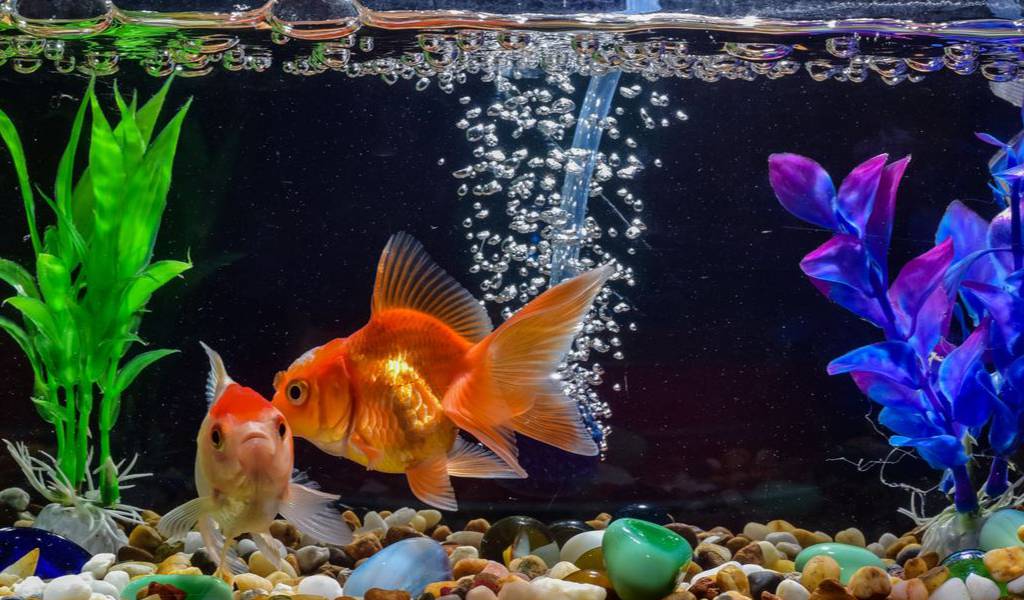
How Often Should Clean the Aquarium Inside the Glass?
Regular maintenance of aquarium glass is essential. But you should avoid cleaning the inside glass frequently, or it will impede the thriving of beneficial bacteria in aquariums and even pose threats to fish. Clean the aquarium’s inside glass every two weeks is a suitable option, including scrubbing the inside glass and removing accumulated algae. However, how often you clean is determined by your aquariums, such as the size of your aquarium, fish species, other creatures, and the real-time water condition.
Cleaning the glass once a day is not necessary. But you should observe your fish for a few moments to check whether they feel comfortable. In addition to this, you can partially clean the inside glass once a week with the fish tank cleaner.
Reminder
You should be careful when you clean the aquarium glass, or your fish may get injured. In addition to all mentioned above, here are also some pointers about how to clean the aquarium inside the glass.
Reduce algae in your tank
Plants are an ideal choice. They not only provide hiding places for fish but also consume food that algae need. Besides, remove the uneaten food, or it will be a food source for algae.
Reduce excessive lighting
Lighting promotes the thriving of algae. Therefore, it is better to keep lighting for about 10 hours a day. Different species may require different lighting hours, so you should determine it accordingly.
Finally, we hope this article has provided useful information for you. Thanks for your reading!
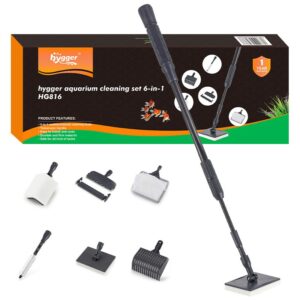
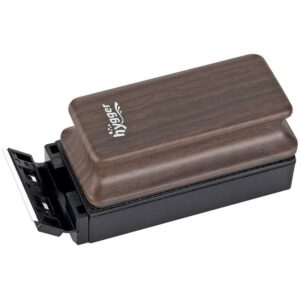
Leave a comment